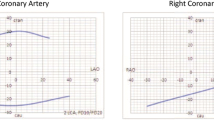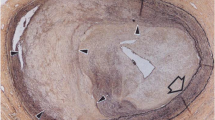Abstract
Annual surveillance coronary angiograpyhy to screen for graft coronary vasculopathy is routine practice after orthotopic heart transplantation. Traditionally, this is performed with direct coronary angiography using static single-plane or biplane angiography. Recently, technological advances have made it possible to perform dual-axis rotational coronary angiography (RA). This technique differs from standard static single-plane or biplane angiography in that a single detector is preprogrammed to swing through a complex 80° arc during a single injection. It has the advantage of providing a perspective of the vessels from a full arc of images rather than from one or two static images per contrast injection. The current study evaluated two coronary angiography techniques used consecutively at a single center to evaluate pediatric heart transplant recipients for graft coronary vasculopathy. A total of 23 patients underwent routine coronary angiography using both biplane static coronary angiography (BiP) and RA techniques at the Children’s Hospital of Wisconsin from February 2009 to September 2010. Demographic and procedure data were collected from each procedure and analyzed for significance utilizing a Wilcoxon rank sum test. No significant demographic or procedural differences between the BiP and the RA procedures were noted. Specific measures of radiation dose including fluoroscopy time and dose area product were similar among the imaging techniques. The findings show that RA can be performed safely and reproducibly in pediatric heart transplant recipients. Compared with standard BiP, RA does not increase radiation exposure or contrast use and in our experience has provided superior angiographic imaging for the evaluation of graft coronary vasculopathy.



Similar content being viewed by others
References
Akhtar M, Vakharia KT, Mishell J, Gera A, Ports TA, Yeghiazarians Y, Michaels AD (2005) Randomized study of the safety and clinical utility of rotational vs standard coronary angiography using a flat-panel detector. Catheter Cardiovasc Interv 66:43–49
Empen K, Kuon E, Hummel A, Gebauer C, Dorr M, Konemann R, Hoffmann W, Staudt A, Weitmann K, Reffelmann T, Felix SB (2010) Comparison of rotational with conventional coronary angiography. Am Heart J 160:552–563
Garcia JA, Agostoni P, Green NE, Maddux JT, Chen SY, Messenger JC, Casserly IP, Hansgen A, Wink O, Movassaghi B, Groves BM, van den Heuvel P, Verheye S, Van Langenhove G, Vermeersch P, Van den Branden F, Yeghiazarians Y, Michaels AD, Carroll JD (2009) Rotational versus standard coronary angiography: an image content analysis. Catheter Cardiovasc Interv 73:753–761
Garcia JA, Chen SY, Messenger JC, Casserly IP, Hansgen A, Wink O, Movassaghi B, Klein AJ, Carroll JD (2007) Initial clinical experience of selective coronary angiography using one prolonged injection and a 180 degrees rotational trajectory. Catheter Cardiovasc Interv 70:190–196
Garcia JA, Movassaghi B, Casserly IP, Klein AJ, Chen SY, Messenger JC, Hansgen A, Wink O, Groves BM, Carroll JD (2009) Determination of optimal viewing regions for x-ray coronary angiography based on a quantitative analysis of 3D reconstructed models. Int J Cardiovasc Imaging 25:455–462
Hudson PA, Klein AJ, Kim MS, Wink O, Hansgen A, Casserly IP, Messenger JC, James Chen SY, Carroll JD, Garcia JA (2010) A novel dual-axis rotational coronary angiography evaluation of coronary artery disease: case presentation and review. Clin Cardiol 33:E16–E19
Kirk R, Edwards LB, Kucheryavaya AY, Benden C, Christie JD, Dobbels F, Rahmel AO, Stehlik J, Hertz MI (2011) The registry of the International Society for Heart and Lung Transplantation: fourteenth pediatric heart transplantation Report–2011. J Heart Lung Transplant 30:1095–1103
Klein AJ, Garcia JA (2009) Rotational coronary angiography. Cardiol Clin 27:395–405
Klein AJ, Garcia JA, Hudson PA, Kim MS, Messenger JC, Casserly IP, Wink O, Hattler B, Tsai TT, Chen SY, Hansgen A, Carroll JD (2011) Safety and efficacy of dual-axis rotational coronary angiography vs standard coronary angiography. Catheter Cardiovasc Interv 77:820–827
Kuon E, Niederst PN, Dahm JB (2002) Usefulness of rotational spin for coronary angiography in patients with advanced renal insufficiency. Am J Cardiol 90:369–373
Maddux JT, Wink O, Messenger JC, Groves BM, Liao R, Strzelczyk J, Chen SY, Carroll JD (2004) Randomized study of the safety and clinical utility of rotational angiography versus standard angiography in the diagnosis of coronary artery disease. Catheter Cardiovasc Interv 62:167–174
Acknowledgments
The authors thank Pippa Simpson, Ph.D., and Yumi Cao, M.S., for their statistical assistance.
Author information
Authors and Affiliations
Corresponding author
Electronic supplementary material
Below is the link to the electronic supplementary material.
246_2012_494_MOESM3_ESM.avi
Left coronary artery rotational angiogram with severe GV. There is moderate stenosis of the proximal circumflex and anterior descending coronary arteries. There is severe narrowing of the first diagonal branch and nearly complete occlusion of the distal anterior descending coronary artery. The mid portion of the first marginal branch is 90 % occluded, and the distal circumflex artery is severely narrowed beyond the origin of the second marginal branch. Note the presence of an implantable defibrillator and the excellent visualization of all the coronary segments as the lead and device are rotated off the coronary arteries. (AVI 61444 kb)
246_2012_494_MOESM4_ESM.avi
Right coronary artery (RCA) rotational angiogram with severe GV. There is severe ostial stenosis of the RCA. The distal vessel is underfilled and appears small. The image is not centered ideally, and the distal portions of the RCA are not seen at the end of the injection. (AVI 46851 kb)
Rights and permissions
About this article
Cite this article
Gudausky, T.M., Pelech, A.N., Stendahl, G. et al. Dual-Axis Rotational Coronary Angiography: A New Technique for Detecting Graft Coronary Vasculopathy in Pediatric Heart Transplant Recipients. Pediatr Cardiol 34, 560–565 (2013). https://doi.org/10.1007/s00246-012-0494-2
Received:
Accepted:
Published:
Issue Date:
DOI: https://doi.org/10.1007/s00246-012-0494-2




